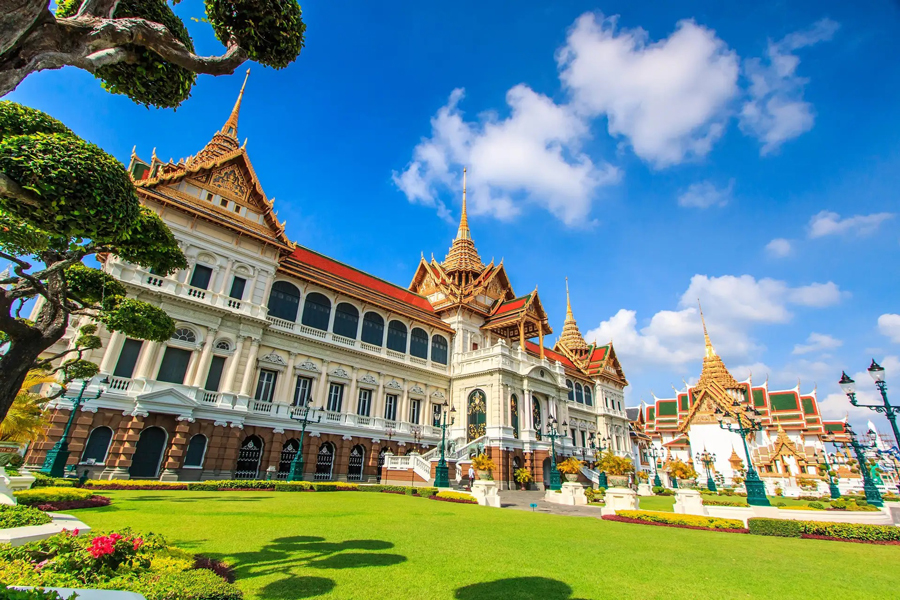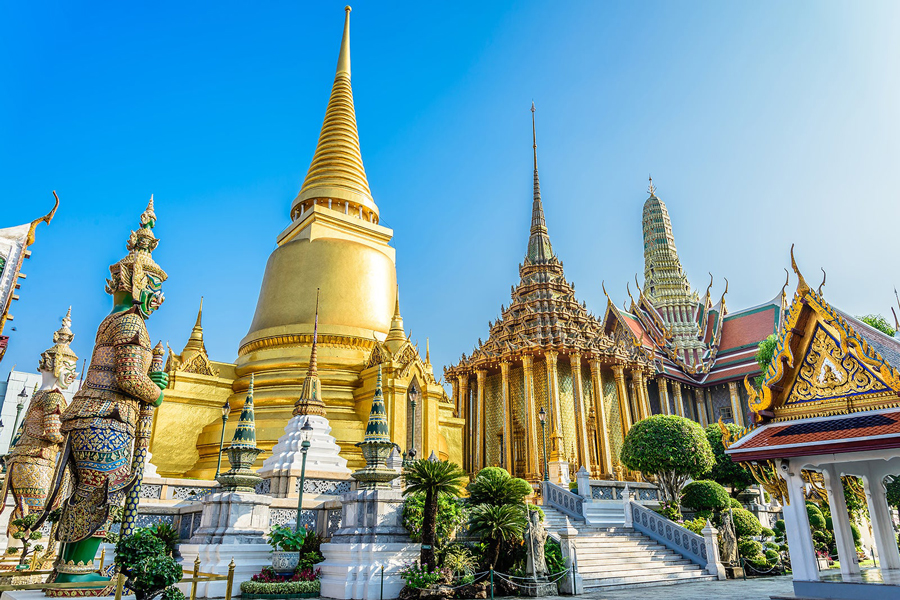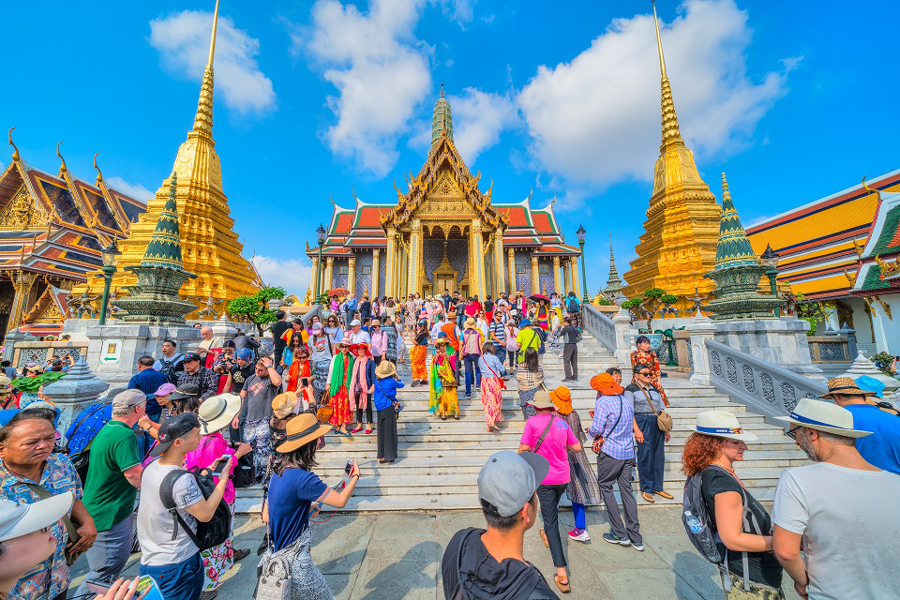Grand Palace

The Grand Palace in Bangkok, Thailand, is an architectural marvel and a cultural gem that stands as a testament to the rich history of the country. Commissioned by King Rama I in 1782, this grand complex served as the official residence of Thai kings for over 150 years. Its breathtaking architecture, characterized by intricate details, vibrant colors, and gilded embellishments, showcases a harmonious blend of Thai, Chinese, and European influences. Divided into the Outer Court, which houses government offices, and the Inner Court, reserved for the king's residence, the Grand Palace is a captivating symbol of the Thai monarchy. Open to the public, the Grand Palace offers a unique opportunity to immerse oneself in Thailand's cultural heritage and witness the splendor of its historic architecture. Let's explore Grand Palace with Asia King Travel!
The Grand Palace in Bangkok has a rich and fascinating history that spans centuries. Its construction was initiated by King Rama I in 1782, who moved the capital of Thailand from Thonburi to Bangkok. The palace was intended to serve as the official residence of the Thai kings and the administrative center of the government.
Within the Grand Palace complex, the Wat Phra Kaew, or the Temple of the Emerald Buddha, holds particular significance. The Emerald Buddha, a small and highly revered statue, was discovered in northern Thailand in 1434. The temple was constructed to house this sacred relic, and it has since become one of the most important religious sites in Thailand.
Over the years, the Grand Palace underwent several expansions and renovations by subsequent kings, each adding their own contributions to the architecture and design. The palace continued to be the primary residence of the Thai monarchs for many years.
In contemporary times, the Grand Palace is no longer the residence of the royal family, but it remains a symbol of Thai heritage, culture, and monarchy. It is a major tourist attraction, drawing visitors from around the world who come to marvel at its historical significance, architectural beauty, and the spiritual importance of Wat Phra Kaew. The Grand Palace stands as a living testament to Thailand's rich cultural and royal legacy.
Unique architecture at the Thai Grand Palace

The distinctive blend of traditional Thai, Chinese, and European styles
At the Thai Grand Palace, the synthesis of ancient and modern architecture is evident. Golden-plated pointed towers and a predominantly white palace exterior coalesce to form a uniquely majestic and grand royal residence. This architectural blend beautifully captures Thailand's rich history while embracing a modern aesthetic.
The majestic hall at the Thai Grand Palace

The spacious interior is adorned with regal embellishment
A notable feature of the Thai Grand Palace is its impressive lobby area, characterized by exquisite architecture and intricately carved details that radiate the opulent beauty of royal splendor. This space serves as the backdrop for significant ceremonies and events hosted by the Thai Royal Family. Notably, visitors have the opportunity to marvel at the ancient throne once used by the kings of Thailand during their reign.
Sacred Wat Phra Kaew Temple

Wat Phra Kaew is a cultural treasure of the Thai Ramakien epic
The Thai Grand Palace is synonymous with the iconic Wat Phra Kaew temple, a once-exclusive space for Thai royalty. Housing the revered Jade Buddha statue, Phra Kaew Morakot, intricately carved with a precious gem dating back over 2000 years, this temple stands as a vital and culturally significant area in Bangkok, encapsulating the rich history and distinctive features of Thai culture.
The Royal Palace of Thailand welcomes visitors every day from 8:30 a.m to 3:30 p.m, with a possible variation in opening hours on special holidays. Admission to the Royal Thai Palace is priced at 500 baht per person. In the event that tourists inadvertently wear inappropriate attire such as shorts or skirts, assistance is available to borrow suitable items from an external facility. This service is provided at no cost; however, a refundable deposit of 200 baht is required when returning the borrowed items.

"When in Rome, do as the Romans" is very important when visiting the Grand Palace
The best time to visit the Grand Palace in Bangkok is during the cooler and drier months, which typically span from November to February. This period is considered the peak tourist season as the weather is more comfortable with lower temperatures and less humidity. During these months, you can expect clearer skies and more pleasant conditions for exploring the intricate details and vibrant architecture of the Grand Palace. It's important to note that the months of March to May are characterized by increasing temperatures and higher humidity levels, making the weather less favorable for extensive outdoor exploration.
The Royal Palace of Thailand may be reached by any of the following modes of transportation after you arrive in Thailand.
By bus: The bus is the best mode of transportation if you want to cut expenditures. The city has many bus lines that lead to the Royal Palace. To find out the best travel instructions, consult the ticket sales personnel.
Taking a Taxi: The majority of Bangkok's routes have taxis, which are incredibly handy and quick. Nevertheless, the location of the cab pickup will also affect the fare.
Travel by rail and boat: In this method, you may purchase a ticket to Sapan Takin station, which is roughly a 20-minute ride away, at the closest train station. After that, keep rowing to Tha Chang Wang Luang dock along the Chao Phraya River. The entry gate will be seen if you go a little distance. At just 15 Baht, the boat ticket is quite affordable